DRAWING SESSIONS








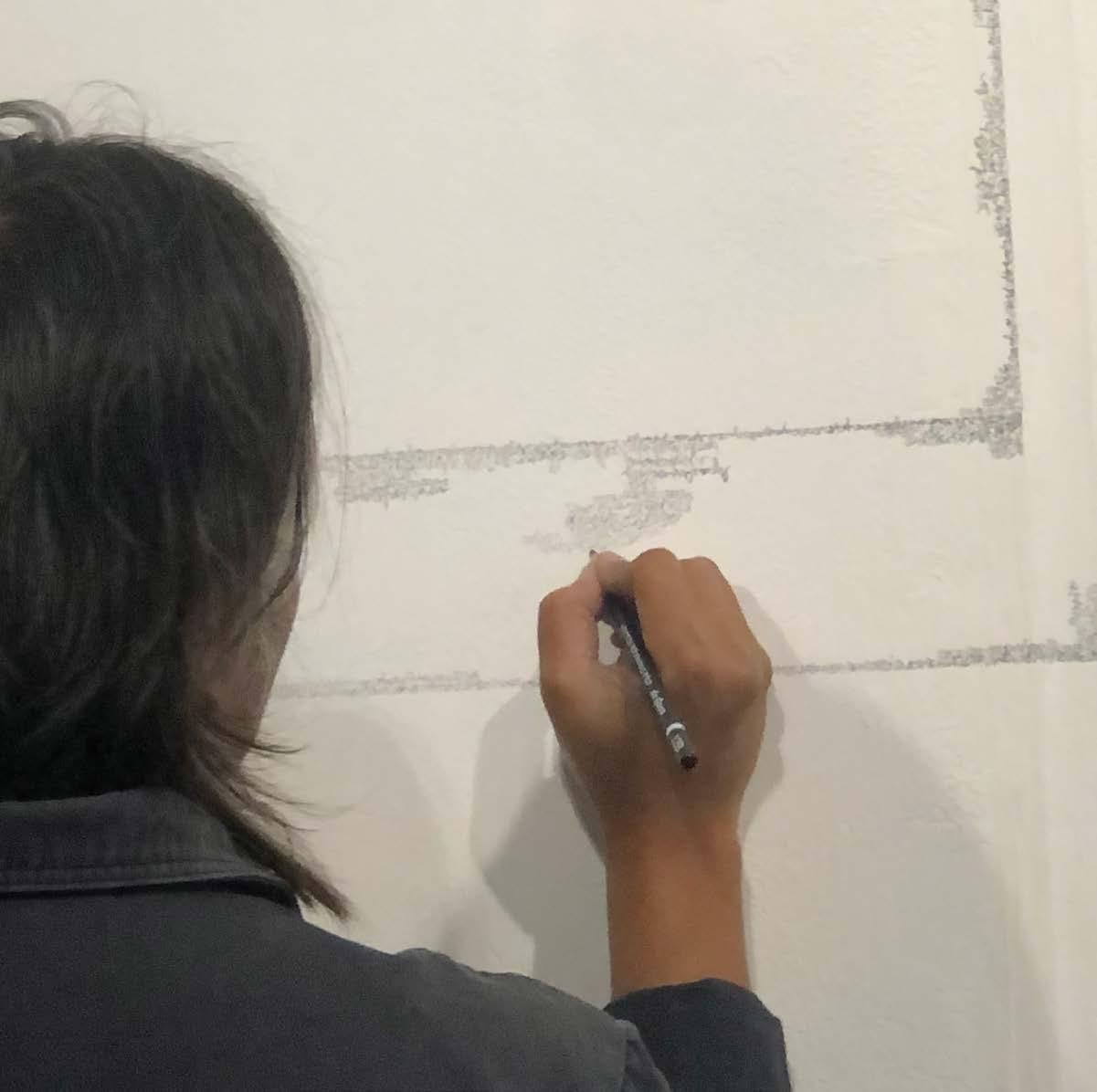
0800-0900 Gustaff H. Iskandar


SESSIONS:
SITTING
Sabtu 9 Maret
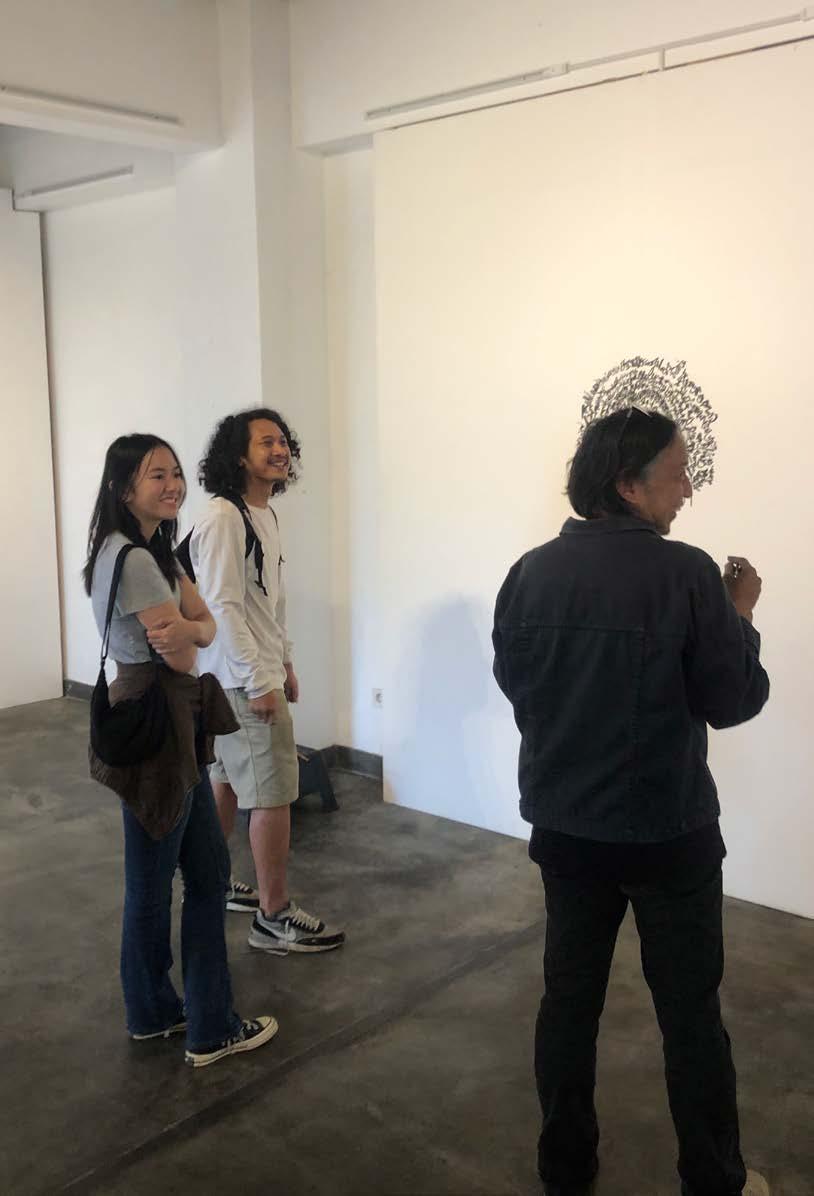

SITTING SESSIONS:
Sabtu 16 Maret
1600-1700 Januar Kristianto
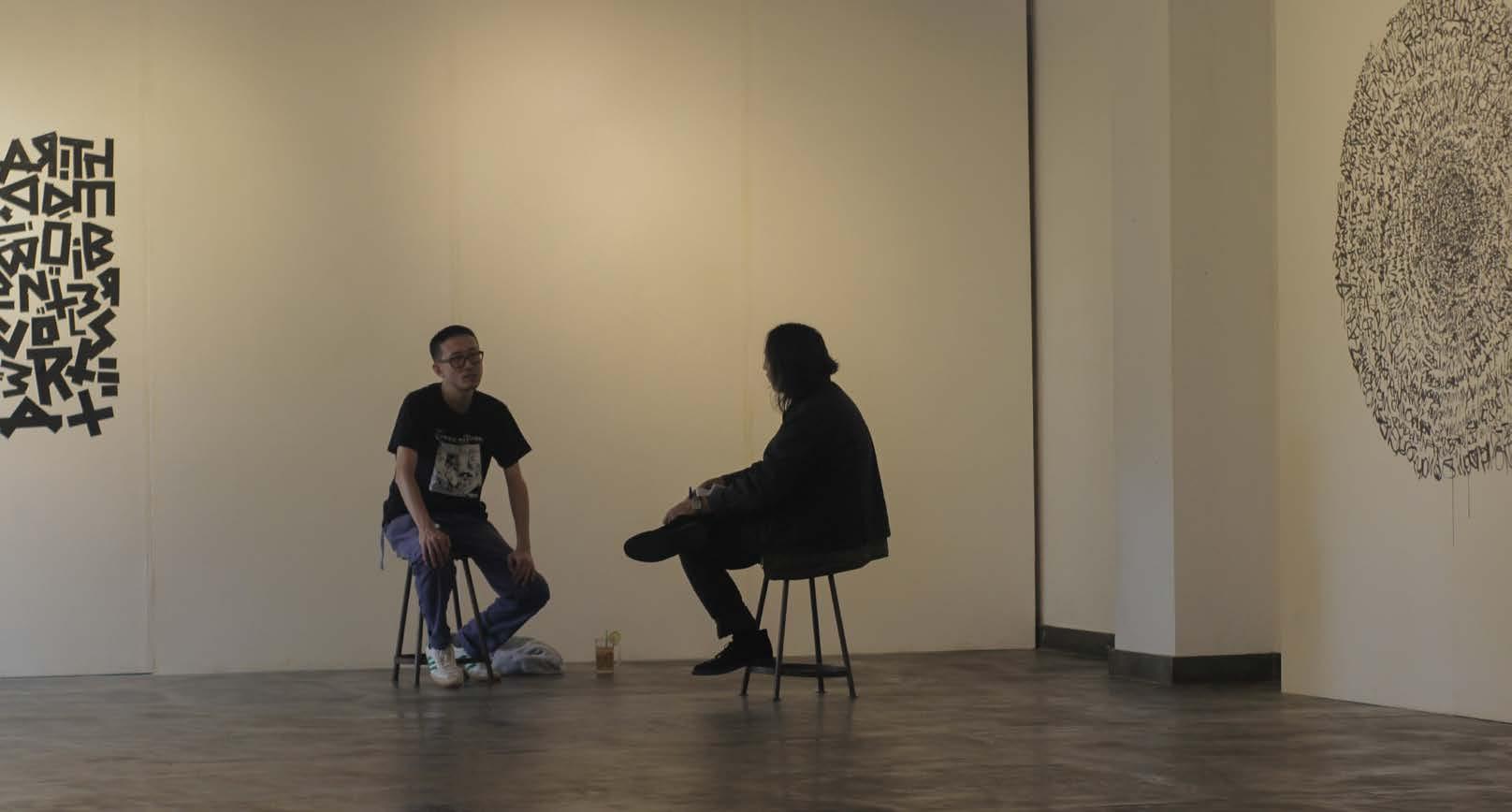
SITTING SESSIONS:
Senin 18 Maret
1300-1400 Mitha Budhyarto

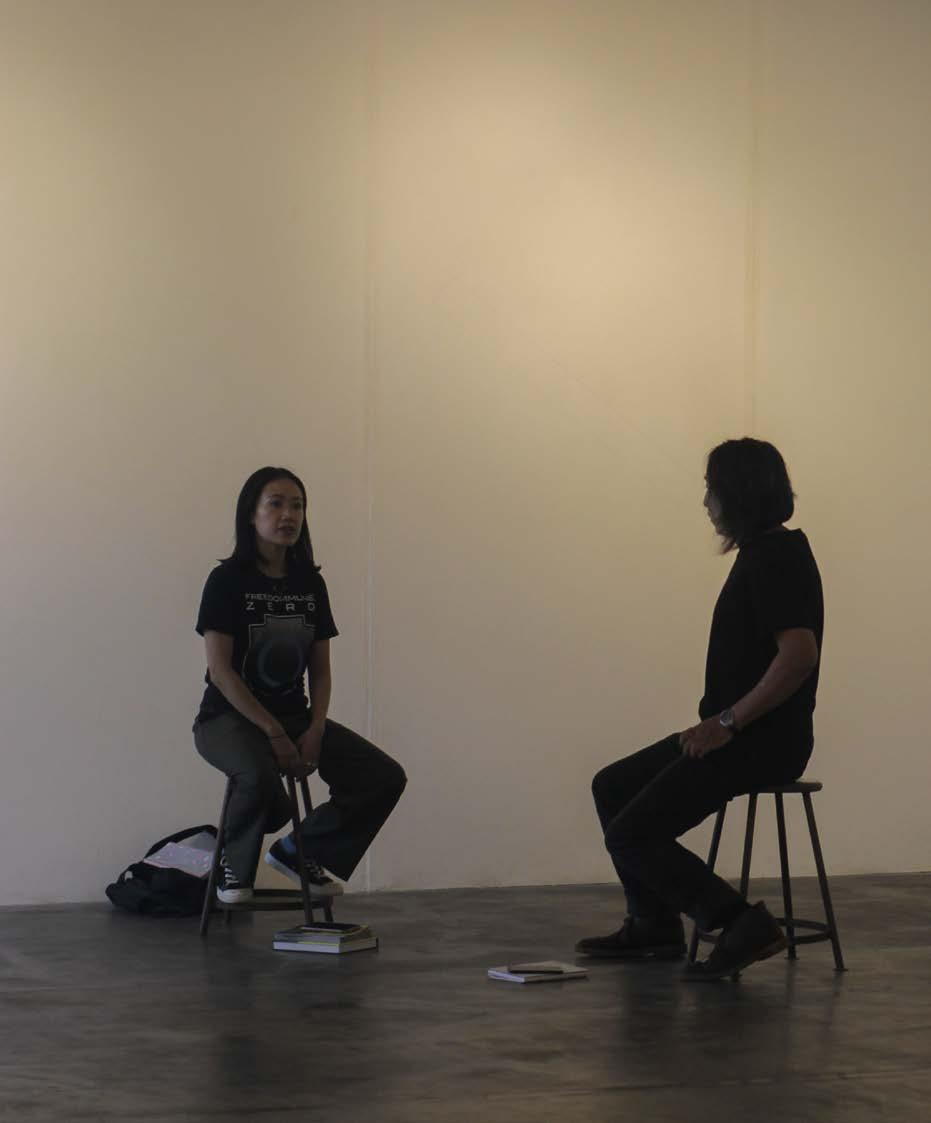




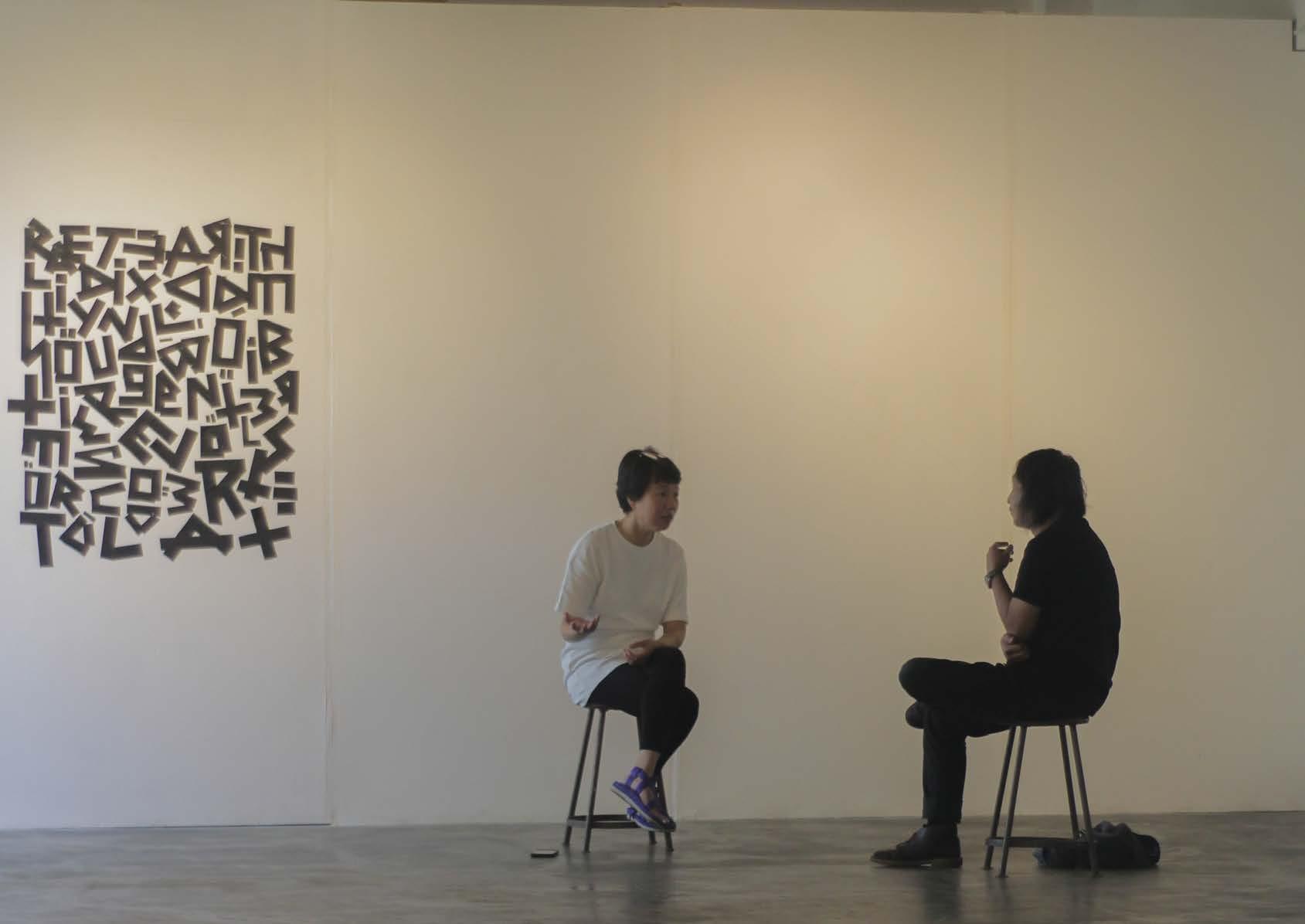
SITTING SESSIONS: Rabu 20 Maret 0800-0900 Mei Suling


RECEPTION AND DISCUSSION


SENIN 25 MARET
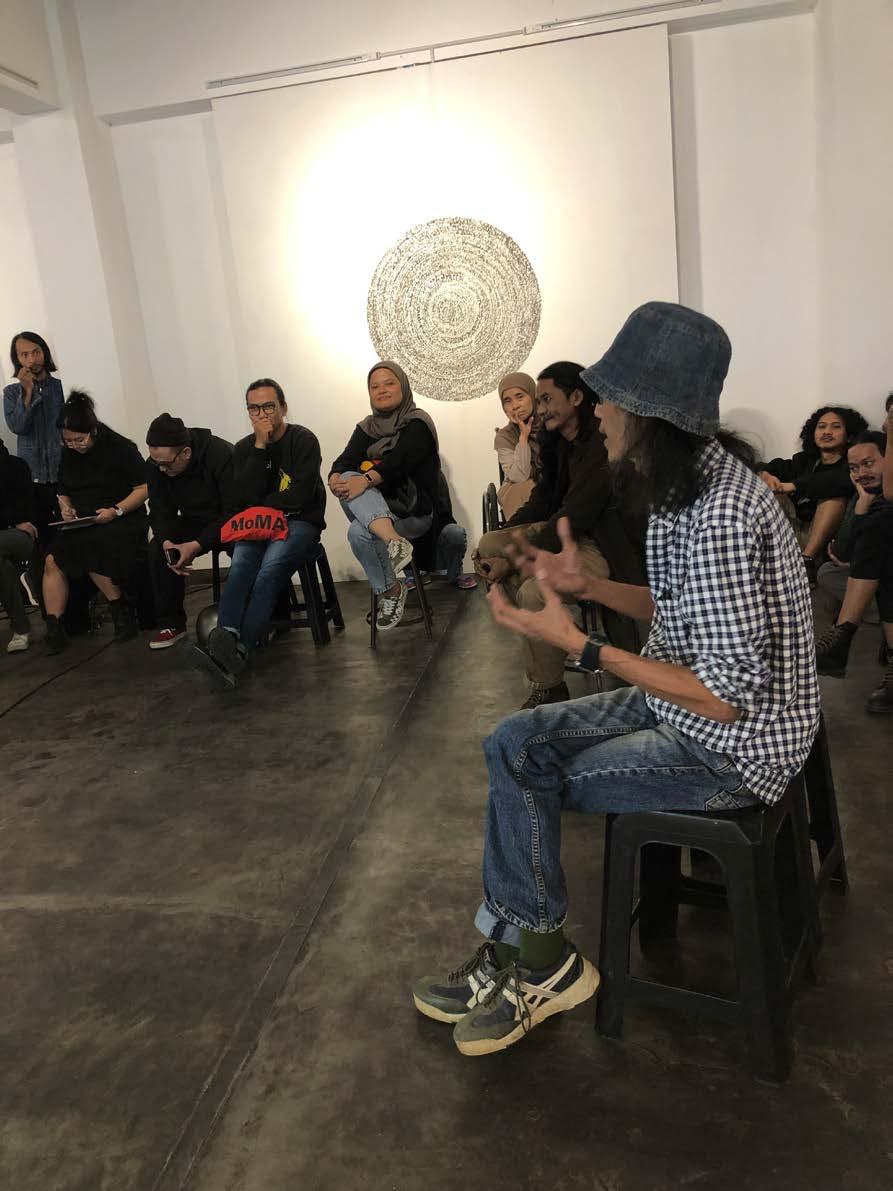
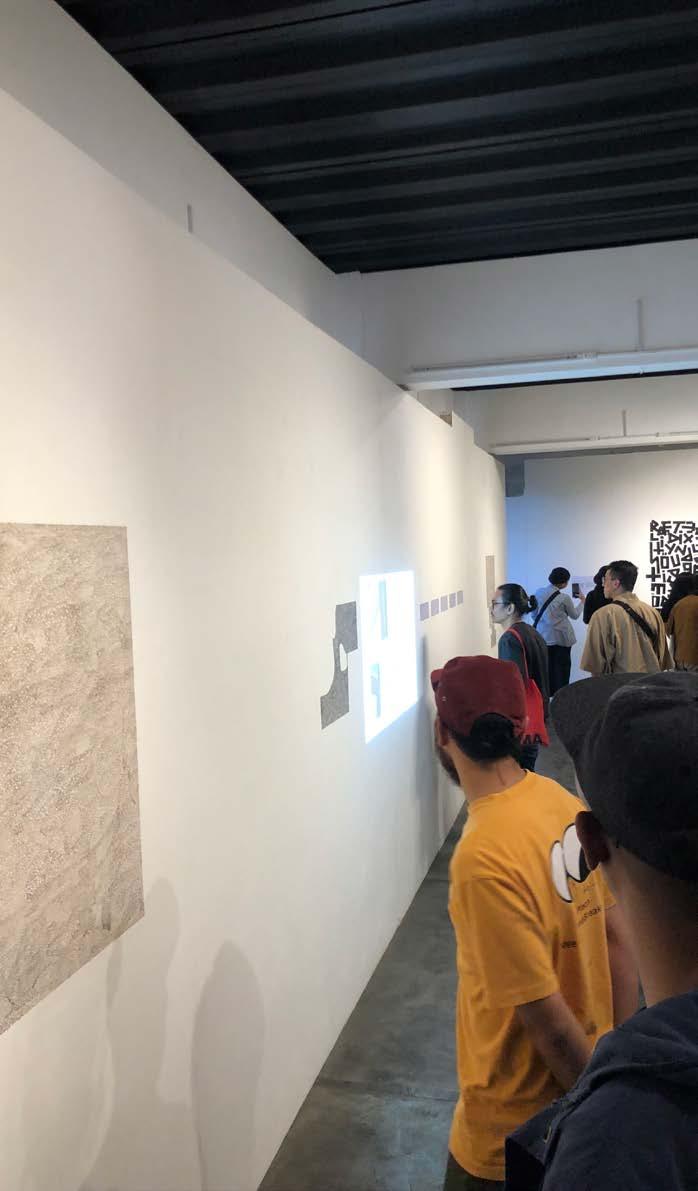
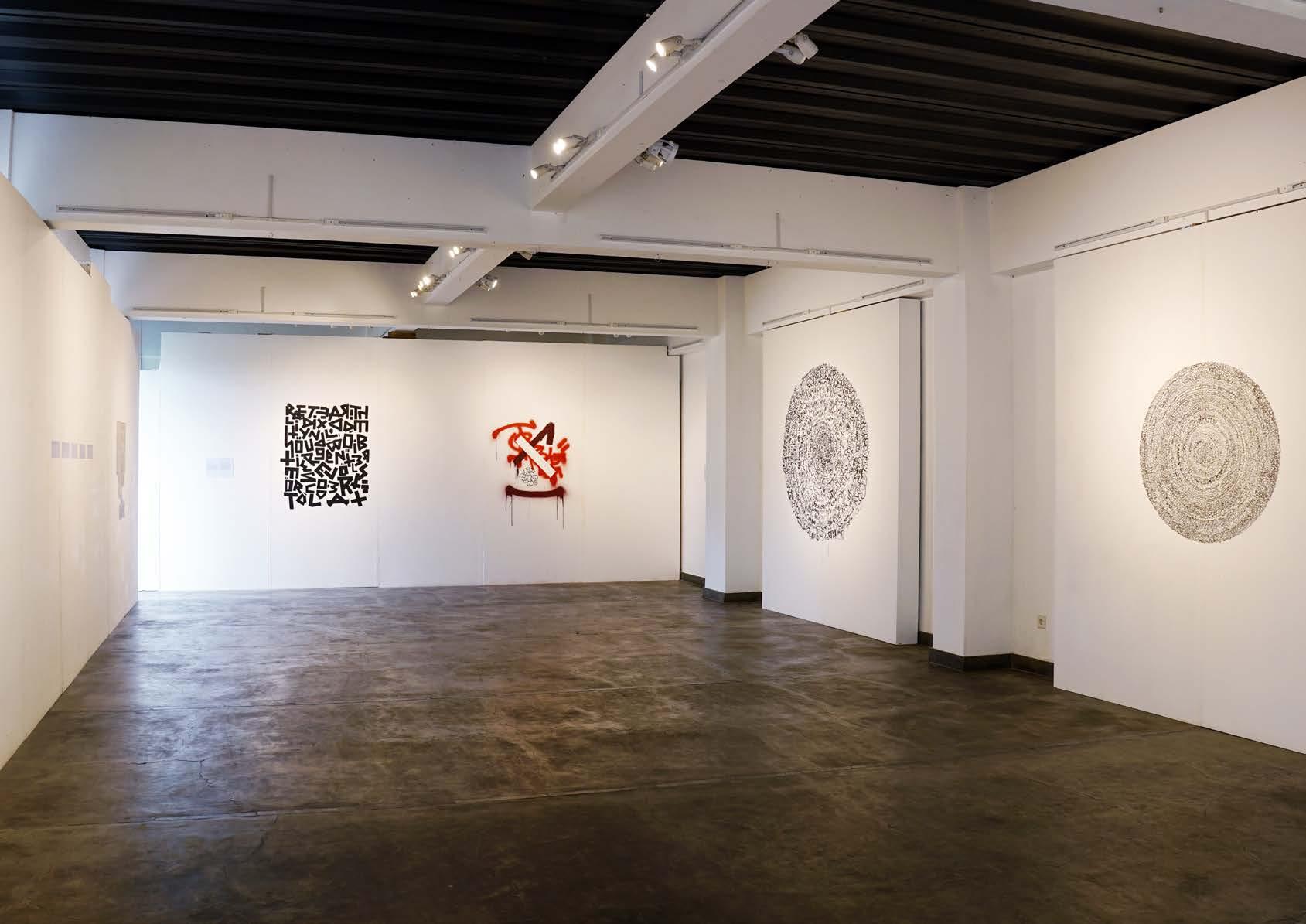
EXHIBITION UNTIL 21 APRIL 2024


fountain pen ink on painted wood
Ari’s is the only work in this project that features all the characteristics that are typical to my previous drawings: portrait in format, filled with allover script with no intentional image reference in mind, besides the knowledge that the resulting cloud/textural output would tease viewers imagination to have their own readings of what some sections might resemble to them. Exactly how I see him at face value.
Its introductory positioning in the gallery space operates as a key, a familiar departure point to assist in the reading of subsequent variations occurring in the rest of the works.
Ari
70x90
I’ve known Uda Al for about a year or so, since working with him for the Open Arms exhibition at Selasar Sunaryo Art Space in 2023. This work reflects my impression of him as a person, an artist, and an advocate for the disabled community: a composite blend of strong will and curiosity/openness to discovering new things and adventures that extends beyond the perceived restrictions of his physical being.
 Uda Al
india ink on painted wood 57x46
Uda Al
india ink on painted wood 57x46

Sidney ballpoint on painted wood 180x10
Those accustomed on seeing Sidney’s designs may recognize the kind of obsessiveness that is at play in their making. There is a degree of specificity to the choice of materials, attention to details and how they fit holistically in the final outcome, and a strong inclination towards the orderly. All of which I attempted to emulate in these five arrangements, while still allowing subtle nuances to appear (whether dimly or otherwise) in certain areas.

fountain pen ink on painted wood
67x87
This interpretation stems from a number of elements gathered during the Sitting Session. There are references to the past; of her studies and interests in the idea of non-places and the everyday; as well as the present — of work/life balance, motherhood, the stream-of-consciousness writing in Virginia Woolf’s Mrs. Dalloway, and the paganistic undertones of her Rites of Spring collaborative project.
The drawing is a compound of stream-of-consciousness arbitrariness (in the horizontal/vertical shape of the script), a sense of the uncanny (in space and form), and an associative play around ‘the woods’ as a notional site of psychological wanderings

Mitha

Ucok
duct tape on painted wood 95x114
Every single drawing in this project is the result of what the Sitting Session yields. The duct tape was unplanned, it was done as intuitive and direct as the model’s expositions to his beliefs during the session: pragmatic, minimum-to-no fuss, words and verses rich in quips and adlibs — messages that stick to the mind, the way the medium does to the wall.
acrylic paint and marker on painted wood
An amalgam of HC/Punk origins, club-savvy, pop/lowbrow literate, and —in his own words— an “endless fascination with the Japanese culture”. Here I was channelling all of those along with Jan’s sXe early days, streetstyle ethos, post-2008 hipsterism, a dash of Cronenberg, and his inkling towards the dystopian and urban decay.

Jan

Gustaff
acrylic ink on painted wood 160cm
When I first met Gustaff at the turn of the millennium, he and Helvi Sjarifuddin were in the midst of developing something that eventually became Trolley Magazine. The preoccupation was clear: subcultural (or ‘sidestream’ concerns and issues), relatively youth-focus, and urban-centric. Two decades past, and upon my return to this hometown, it was curious (and no doubt surprising) to discover how he’s shifted his attention towards the rural. Yet despite this progression I still see him as the same person I knew back in ‘99. Someone who’s like a vortex of ideas, who’d communicate his thoughts in a kind of structured freeform articulation of ramblings and philosophical musings, much as I imagine what a cosmic mold would be like. A state that is constantly in the brink of something.
Mei sumi ink on painted wood 100cm
The placement of the drawings in this space was predetermined based on my initial preconception on how the individuals/models would translate as geometric (or in some cases organic) shapes. Mei’s therefore was determinant for two reasons. On the one hand, her circular likeness is necessary to complement Gustaff’s. They operate as accompaniment to one another in the sense of denoting two strands of spiritual calls: one of forceful vigor, and another of rhythmic pulse. On the other hand, the circle here acts as a pivot that binds the rest of the drawings together within the space. An equilibrium.


Mandy graphite on painted wood 148x85
Graphite as a medium of choice was already decided early on before the Sitting Session began. It felt suitable to depict the model’s demeanor and mannerism. The planar/schematic layout is derived from a number of things. First, as a result of an online conversation we had shortly after the Sitting, regarding a paper on Giles Deleuze’s pro-Palestine writings in the 1970s and 1980s. This input is then extrapolated in the form of a rhizomatic approach to the drawing/writing process (taking into account Guattari’s role in the original formulation), seeing it as still applicable alongside and inline with the Second and Third aspects, that is Mandy’s research interest in screen-based aesthetics (cyber-oriented/network discourses, internet/net.art), as well as in the floorplans of her curatorial roles.


StuPa
acrylic marker on painted wood 220x340
The stupa appearance stemmed from how Studio Pancaroba’s spokesperson calls themselves in our WhatsApp chats, simply as ‘StuPa’. I thought the abbreviated nickname and the essence of the stupa shape would work well combined. Stupas being structures that contain relics of religious significance, while StuPa as a collective is similarly a structure (or a heap) of sorts, whose concerns and actions are direct jabs and commentaries of the city —on how it’s designed/governed, and the social implications that follows— and the piling up of unruly consequences resulting from them.
Krishnamurti Suparka is an artist and writer based in Bandung, Indonesia. His practice is grounded in notions of drawing, whose articulations range from the paper-based to mixed-media installations. He uses drawing’s inherent transitory nature as a foundation for subsequent explorations across surfaces, often engaging in treatments involving the material and the conceptual. Drawing in this context is synonymous with trace; of what was, what is, and what could be; encouraging multiple viewpoints in approaching the works. His works are reflections on contemporary society. Of the consequences of history, technology, and material progress upon nature and the human, of information abundance and its effects on knowledge acquisition in an increasingly memefied/post-truth spectacle-reality, and on the workings of language and linguistic codes in a connected world; all rendered in the vocabularies of abstraction and conceptualism.
Education
2011 MFA (Research), Victorian College of the Arts - The University of Melbourne
2009 BFA (Honours), Victorian College of the Arts - The University of Melbourne
2003 Graduate Diploma of Education, The University of Melbourne
2001 Bachelor of Fine Art (Drawing), The Victorian College of the Arts
1998 Associate Diploma of Art (Visual Art), RMIT, Melbourne
1994 Advanced Certificate in Design (Graphic Design), Swinburne University, Prahran, VIC
Solo Exhibitions
2013 They Came From the North, Place Gallery, Melbourne, AU
2005 Postscript, btw_space, Bandung, Indonesia. Sentence/Sententia, Room#1, Bandung, Indonesia
1997 Stalactite, Spare Room, Melbourne, AU
Selected Group Exhibitions
2023 Hitam, Grey Gallery, Bandung, INA
2022 ICAD 12: Fragmenting Yesterday, Reshaping Tomorrow, Grandkemang, Jakarta, INA Hamin, Studio Mogus, Yogyakarta, INA
2020 Reading, Writing, & Test Pressing, Grammars, Bandung, INA
2017 Felt Project, Spasial, Bandung, INA
2013 Drawing, Metcalfe Gallery, Brisbane, AU
2012 Innovators 3, Linden Gallery, Melbourne, AU Emerging Artists, Hawthorn Studio Gallery, Melbourne, AU Matter and Space, Ne Na Contemporary, Chiang Mai, THA 2011 Hand Drawn Boom, Paradise Hills, Melbourne, AU Untitled, Sardam Gallery, Sulemani, KRI
2010 A Wound, Disembodied, Seventh Gallery, Melbourne, AU Art / Word / Image, University of West Georgia, West Georgia, USA
2009 Deer Andry (A Tribute), Touring Exhibition, INA
2005 Heri Dono: Licking the Ozone, Melbourne Fringe Festival, Melbourne, AU
Class of ‘95, Common Room, Bandung, INA
2002 Rhizome Project, British Council, Jakarta, INA
2001 VCA Awards Exhibition, VCA Gallery, Melbourne, AU
2000 Travels in Time, Gertrude Contemporary, Melbourne, AU Pasar Seni ITB, Bandung Institute of Technology, Bandung, INA
1999 Carbon Body, George Paton Gallery, Melbourne, AU Occupation, VCA Gallery, Melbourne, AU
1997 Vulnerable Environments, RMIT First Site, Melbourne, AU Awards
2013 Australian Postgraduate Award
2012 Linden Gallery Award
2010 Australian Postgraduate Award University of Melbourne Travel Award
2009 Commonwealth Support Program (Research Scholarship)
2002 British Council Award
2001 Christine Abrahams Award
Selected Publications
2023 whispers in the lesser cosmos, Ginanjar and Suparka exhibition text, Galeri Ruang Dini Supposes, group exhibition text, SAL Projects at Artotel Thamrin, JKT
No Themes No Worries, Eddi Prabandono and Abdi Setiawan exhibition text, Galeri Ruang Dini UR My Inspiration, Beyond Crap exhibition text, Selasar Sunaryo
Terra Nova, Iman Skyone and Mufti Widi exhibition text, Galeri Ruang Dini
2022 The Hotel, exhibition text, ICAD 12, Grandkemang Poems Around the Room, Dewi Aditia exhibition text, Jakarta The Mind is an Archipelago, Flukeminimix album text, Disaster Records Coda, On Frequency by Kimung, Atap Publishing
2021 Mapping The Commons Across The Spectrum, curatorial text, Bandung Design Biennale Emancipated Footnotes, Further Reading Print No.3, Further Reading Press
Foreword, NM Documents, Sembilan Matahari
2019 Pengantar, Based on a True Story: Pure Saturday by Idhar Resmadi, Gramedia Search/Destroy, Deathless album liner notes, Blank Orb Recordings
2009 Recollections/Reconstructions, artist’s book, self-published
2002 Between The Inbetween, album liner notes, Spills Records
Selected Press and Reviews
2023 ‘Anonymous internet persona Beyond Crap takes material jabs at the *** World’, A. Ariwandono, exhibition review, The Jakarta Post
2021 ‘A Moment of Reflection with Bandung Design Biennale’, L.N.I. Siringoringo, review, Manual Jakarta 2019 ‘Mencari Jejak Pra-Indies’, Bandung Pop Darlings book chapter, I. Muhammad, EA Books
2012 Innovators, S. Wark, exhibition catalogue text, Linden Gallery
2010 ‘Schwartz, Suparka’, P. Webb, exhibition review, The Age
2005 ‘Rekonstruksi’, H. Sutresna, exhibition text, Room#1
2001 ‘An Appreciation of Time and Space’, R. Nelson, exhibition review, The Age 2001 Travels In Time, S. Comte, exhibition catalogue text, Gertrude Contemporary

Memotret Kenangan Seseorang yang (Tidak) Dikenal
(Catatan Jajang Supriyadi)
Pameran seni rupa ini bertajuk “Ten Portraits” (After Stein, After Warhol, After 150 Days), merupakan presentasi tunggal dari Krishnamurti Suparka, di Orbital Dago, Bandung, berlangsung sejak tanggal 7 Maret hingga 21 April 2024. Di dalamnya menyajikan himpunan karya berupa drawing pada dinding ruang galeri (locus; site specific), yang tumbuh melalui interaksi dan percakapan. Krishna Suparka melibatkan 10 orang rekan dekatnya sebagai model dan teman bercakap, antara lain: Ari Patria, Faisal Rusdi, Herry Sutresna, Amanda Ariawan, Gustaff H. Iskandar, Studio Pancaroba, Januar Kristianto, Mitha Budhyarto, Sidney Islam, dan Mei Suling. Setiap rekannya diundang datang ke galeri, di hari berbeda, dalam durasi berlainan, sepanjang tanggal 7 hingga 24 Maret 2024. Sementara penggarapan drawing dilakukan bersamaan dengan waktu bersitatap, ada juga yang setelah melewati beberapa hari kemudian. Selain itu, seniman juga telah menetapkan letak dan bagian setiap drawing dari modelnya ditempatkan. Tampak tidak terjadi tawar-menawar, seniman sejak awal telah mendesain alur dan display hasil karyanya nanti dalam ruang galeri. Penetapan waktu bertemu dengan model serta area display karya, menunjukkan pentingnya “memento” dan “locus”, semacam koreografi yang dengan sadar, terukur dilakukan seniman menuju kebulatan gagasan dalam pameran.


Pada tanggal 25 Maret 2024, pameran ini dibuka secara umum dan disertai dengan diskusi untuk publik. Dalam acara tersebut, seniman memberikan penjelasan tentang pameran dan karya-karya yang disajikannya. Diskusi juga menjembatani aspek diskursus yang tumbuh, menyoal judul pameran dan rekam-catatan sepanjang penggarapan karya. Krishnamurti Suparka dengan rinci mengurai dan memberi bubungan pemahaman pada publik untuk mendapati sejumlah pengalaman, baik empirik, estetik, serta reflektif melalui karya-karyanya. Melalui 10 karya drawing yang disajikan, tampak memiliki ungkapan dan perlakuan berbeda. berusaha menampilkan potret sebagai suatu tangkapan jejak percakapan atau “memento” yang menggambarkan setiap modelnya. Potret model yang dimaksudkan tidak berupa sosok, seperti umumnya dalam foto atau lukisan. Tidak berupa raut wajah seseorang. Melainkan mewujud himpunan garis dan teks yang disusun sedemikian rupa. Membentuk formasi-formasi yang dapat dikenali ke dalam bentuk dasar; seperti sirkular, segitiga, persegi asimetris, dan lainnya dengan material kerja pensil, ballpoint, spidol, serta cat semprot. Susunan garis dan teks tersebut lebih tampak seperti cerita yang merupa, menggambarkan keintiman antara seniman dengan model-modelnya. Merekam “memento” puitik, tidak utuh terbaca, sebagian tersimpan sebagai catatan tertutup; antara seniman dan model-modelnya.

Cara kerja yang dilakukan Krishnamurti Suparka tidak sedang menerjemahkan isi percakapan dan interaksi dengan 10 model ke dalam drawing. Namun penekanannya pada menangkap dan merekam “memento”, suatu keadaan jejak, kenangan, atau tinggalan yang menyatakan keadaan diri seseorang pada saat pertemuan berlangsung. Seniman seakan sedang merumuskan ulang siapa model, seseorang yang tumbuh dalam percakapan, tidak sebatas biografinya. Membuat drawing seperti menyusun jejak, tinggalan, kenangan tentang seseorang melalui percakapan menjadi sosok yang sebenarnya berjarak. Maka yang dimaksudkan adalah kondisi berjarak atas biografi setiap model. Walau pun tentu saja pilihan menetapkan sekian model lebih karena kedekatan sebagai rekan, menjadi suatu kecurigaan tersendiri. Apakah mungkin dapat berjarak? Sebaliknya, apakah justru karena sebagai rekan dekat biografi seseorang tidak mungkin dilepaskan. Jika cara kerja seni rupa mengandalkan pengamatan (termasuk melalui interaksi dan percakapan), juga terjadi pada saat membuat drawing. Dalam pameran ini hal yang sama berlaku, setiap karya diberi jejak pengamatan, berupa penjelasan penyerta di sampingnya. Melalui jejak tersebut, seniman tampak tetap memiliki rekaman biografis tentang siapa modelnya, karena bertahun-tahun menjadi rekan. Maka dalam karya-karya yang disajikan dalam pameran ini seperti mengandung dua tegangan, antara potret model biografis dengan model yang sama sekali baru; bioritmis terikat percakapan, ruang dan waktu.
Jika pengertian “After” dalam praktik seni rupa menjadi pijakan karya-karya yang dibangun Krishna Suparka, adakah hanya sekadar untuk membuktikan keterhubungan dan kemiripannya? Apa yang membedakan cara kerjanya dengan yang dilakukan Gertrude Stein (1930) dan Andy Warhol (1980)? Jika perbedaan hanya pada pilihan medium dan hasil akhir, adakah Krishna Suparka mencurigai adanya tegangan gagasan tentang model-model yang dipilihnya? Cara kerja merujuk yang terdahulu pernah dilakukan seniman lainnya, adalah hal yang cukup lumrah dilakukan dalam praktik seni rupa. Baik sebagai rujukan langsung (citation; sitasi), maupun sekadar apropriasi dan atau berupa sebentuk penghormatan (tribute, memuliakan). Sekurangnya dihadirkan dalam ragam karya seni rupa. Namun jangkauan pengertian “After” juga mengandung ruang gerak, bahkan negasi. Kesejajaran dan keterhubungan tidak hadir begitu saja, sebatas melalui literatur atau bacaan seniman. Dapat pula menjelma pertanyaan, keadaan apakah yang hendak digapai dan bagikan pada publik? Jika penekanan pada “memento” dan “locus” menjadi penting, dapatkah menyertakan orang asing sebagai modelnya, dan bukan seseorang yang dikenal sebelumnya? Pengertian “After” dalam pameran ini, pada dasarnya menyertakan ruang pemahaman yang justru terbuka---tidak lagi menjadikan sesuatu yang di belakang sebagai acuan. Justru bergerak untuk mengurai simpul pemaknaan pada cara kerja berkarya yang sebelumnya pernah dibangun sebagai sumber yang memungkinkan diperiksa kembali.

Penyajian karya-karya Krishnamurti Suparka di Orbital Dago tentu saja menarik, ketika beragam pameran seni rupa akhir-akhir ini cenderung larut dalam pemujaan pembuatan rupa (image-making), baik sebagai aspek formal maupun keterkaitannya dengan kelimpahan budaya visual di sekitar. Pameran ini menguatkan aspek diskursif yang sejatinya menjadi bahan bakar praktik seni rupa kontemporer. Menyoal identifikasi tentang pemahaman sekitar potret sebagai salah satu idiom rupa, dan meluaskannya bukan semata perkara mimikri atas bentuk. Sebaliknya memperkenalkan kemungkinan tangkapan atas “memento” dan “locus” dari interaksi dengan model dalam menggarap potret melalui drawing. Menawarkan pemahaman yang lain atas raut, karakteristik, struktur, identitas tentang seseorang melalui jejak naratif pada ruang dan waktu spesifik (site-spesific). Pameran seni rupa yang disajikan Krishnamurti Suparka kemudian menjadi tidak mudah dipahami, tampak rumit dan terasa mengutamakan konsep-konsep serta sejumlah pengetahuan filosofis. Pengamat diminta memiliki kognisi yang memadai untuk memahami dan menyadari apa yang dipentingkan dalam karya-karyanya. Jika tanpa penjelasan dan bahkan ada pun, tetap menyisakan tuntutan agar pengamat tidak sekadar menatap yang tampak, melainkan juga menemukan narasinya. Seperti mencari dan menemukan kenang-kenangan tentang seseorang, dikenali melalui sisa percakapan pada suatu tempat di waktu tertentu, baik yang biografis atau pun bioritmis, berjejalin pada karya-karya dalam pameran ini. Melaluinya terbuka untuk didapati pengertian tentang potret sebagai cara kerja dalam berkarya yang barangkali berbeda, jika tidak dikatakan baru.
Jajang Supriyadi, 26 Maret 2024. (Kritikus Seni Rupa tinggal di Bandung)


Ten Portraits (after Stein, after Warhol, after 150 Days)
by Krishnamurti Suparka
Photography :
Muftiwidi
Beni Beno
Adi Rahmatullah




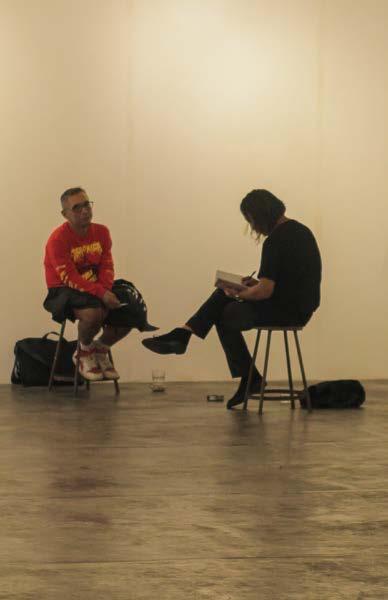


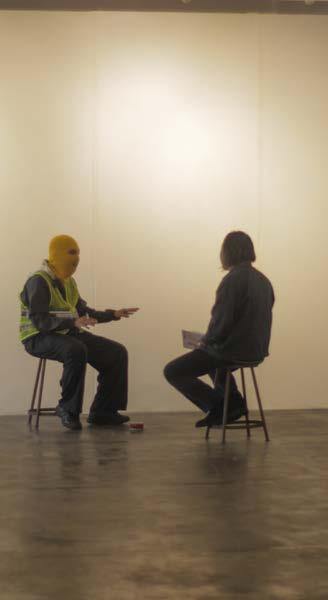









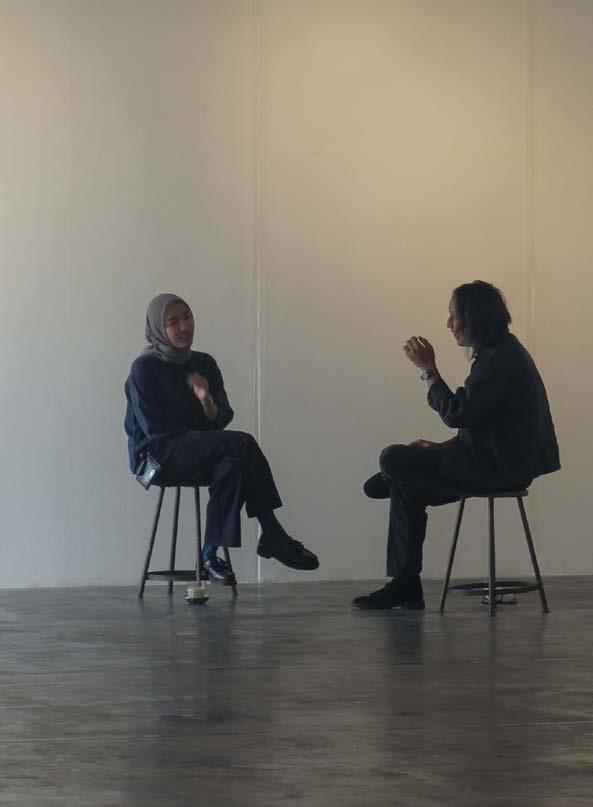





































 Uda Al
india ink on painted wood 57x46
Uda Al
india ink on painted wood 57x46
















